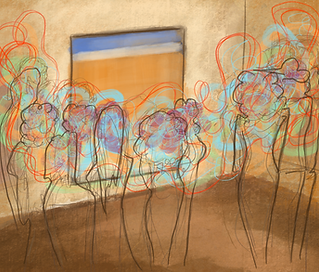About Grey Matters CU
Grey Matters Columbia University is a literary undergraduate neuroscience journal dedicated to evolving the way we approach, discuss, and research neuroscience and its connections to other areas of study. Neuroscience has an intimidating stigma attached to the field, and our mission is to break down that intellectual barrier to permit the knowledge of neuroscience to be accessible and available to all. We wish for a conversation about neuroscience to happen as casually as a conversation about the newest blockbuster movie.
The Grey Matters Journal was originally founded at the University of Washington with the goal of universality and accessibility in mind. Nationwide, each chapter is led by undergraduate students who are passionate about fostering public interest, curiosity, and participation in neuroscience.
Our goal is to convey the interdisciplinary nature of science, particularly neuroscience, to individuals both inside and outside of the STEM field. We have covered topics across a range of disciplines from linguistics to the visual arts, and will continue to explore the intersection of neuroscience with other academic disciplines. We both welcome and encourage all students, faculty, and community members, no matter their areas of study and work, to engage with the magazine. We aim to forge a membership and readership community that reflect the intellectual diversity of Columbia University and New York City at large.
Our Divisions —
Our polished, final publication that can be shared with our community is only the result of hours upon hours of brainstorming topic ideas, researching scientific literature, sketching potential illustrations, editing for accessibility and clarity, and—most importantly—collaboration between our team members. We have five divisions that make up our publication team. Check out the "APPLY" tab if you're interested in joining the GMCU, and feel free to reach out to any of our division heads with specific questions!
WRITING
"To write for Grey Matters is to be a light illuminating neuroscience for the public eye. Authors compose articles about cutting edge neuroscience research from diverse lenses, including but not limited to a psychological, biochemical, computational, and physiological perspective. While all articles in our journal are rooted in neuroscience, it is a vastly interdisciplinary field. We encourage authors to write about any topics that may inspire them, and especially welcome articles that highlight the overlap between neuroscience and other disciplines."
Rochelle Vayntrub
Editor in Chief

REVISION DIVISION
"The Revision Division supports writers in communicating their ideas to our audience clearly, concisely, and compellingly. Our unique role as the only editors who work with a new article each week allows us to interact with each piece from the fresh perspective of a reader. We understand how daunting and technical neuroscience literature can be, so our division is dedicated to limiting scientific jargon and refining the textual representation of our writers’ arguments. By the end of our publication cycle, each article has received constructive input from multiple Revision Editors to ensure the highest degree of clarity and accessibility. Through promoting these values, we aim to spark curiosity and a love for neuroscience in all who engage with our journal, one brainy article at a time."
Perrin Rudensky
Senior Editor of Revision

GENERATIVE EDITING
"The role of Generative Editing is almost fully described in the name itself. In short, we assist authors by editing during their process of generating the articles. This entails making sure the article is well structured, making sure the main ideas are clearly presented to the reader, and most importantly making sure those ideas are adequately developed throughout the article. To do this, we work closely with the article writers during every stage of the writing process: we constantly check to see if any reorganization within the article could augment accessibility and we keep a close eye on the general conceptual structuring of the article. I like to think of the task as something like that of a classmate reviewing a friend’s draft essay: we don’t edit the grammar nor the scientific accuracy of the piece, rather our editorial task is focused on the logical structure of the piece as a whole. As generative editors, we not only ensure that the ideas of the article are easy to understand, but also that the article is free from any glaring conceptual holes."
Tyler Olds
Senior Editor of Generative Editing
.png)
ILLUSTRATION
"In the pursuit of breaking intellectual barriers and creating accessible content, the illustration division of Grey Matters explores the intersectionality of art and science. Art and science are fundamentally about observation and interpretation, both of which aim to explore and discover the unknown mysteries of the world. Therefore, the illustrators of Grey Matters seek to create relatable and enjoyable artwork to help enhance the reader’s ability to connect with the inspiring field of neuroscience."
Hailey Kopp
Art Director

SCIENTIFIC REVIEW
"At the Division of Scientific Review, we separate fact from fiction by vetting the accuracy and integrity of all scientific processes and mechanisms presented in articles before they are published. We are detail-oriented and task-focussed. Our team of knowledgeable Scientific Editors are trained to work collaboratively with writers as research aids and content editors throughout their writing process. They are encouraged to bring innovations through constructive criticism while combining the standard of science with literature. Graduate Student Reviewers from specialized branches in neuroscience perform the final fact-check after Scientific Review Editors complete their evaluations. The position of Scientific Review Editor is more suited for applicants with a rigorous science background. As the leader of the Scientific Review Division, I am committed to overseeing the transmission of authentic neuroscience to the public.”
Sylvester Benson
Senior Editor of Scientific Review





